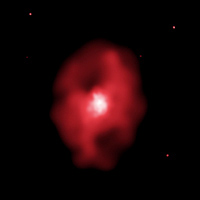Most powerful eruption in the universe discovered

This Chandra image shows two vast cavities - each 600,000 light years in diameter - in the hot, X-ray emitting gas that pervades the galaxy cluster MS 0735.6+7421 (MS 0735 for short).
Astronomers have found the most powerful eruption in the universe using NASA’s Chandra X-ray Observatory. A super massive black hole generated this eruption by growing at a remarkable rate. This discovery shows the enormous appetite of large black holes, and the profound impact they have on their surroundings.
The huge eruption was seen in a Chandra image of the hot, X-ray emitting gas of a galaxy cluster called MS 0735.6+7421. Two vast cavities extend away from the super massive black hole in the cluster’s central galaxy. The eruption, which has lasted for more than 100 million years, has generated the energy equivalent to hundreds of millions of gamma-ray bursts.
This event was caused by gravitational energy release, as enormous amounts of matter fell toward a black hole. Most of the matter was swallowed, but some of it was violently ejected before being captured by the black hole. “I was stunned to find that a mass of about 300 million suns was swallowed,” said Brian McNamara of Ohio University in Athens. “This is as large as another super massive black hole.” He is lead author of the study about the discovery, which is in the January 6, 2005, issue of Nature.
Astronomers are not sure where such large amounts of matter came from. One theory is gas from the host galaxy catastrophically cooled and was swallowed by the black hole. The energy released shows the black hole in MS 0735 has grown dramatically during this eruption. Previous studies suggest other large black holes have grown very little in the recent past, and that only smaller black holes are still growing quickly.
“This new result is as surprising as it is exciting,” said co-author Paul Nulsen of the Harvard-Smithsonian Center for Astrophysics, Cambridge, Mass. “This black hole is feasting, when it should be fasting.”
Radio emission within the cavities shows jets from the black hole erupted to create the cavities. Gas is being pushed away from the black hole at supersonic speeds over a distance of about a million light years. The mass of the displaced gas equals about a trillion suns, more than the mass of all the stars in the Milky Way.
The rapid growth of super massive black holes is usually detected by observing very bright radiation from the centers of galaxies in the optical and X-ray wavebands, or luminous radio jets. In MS 0735 no bright central radiation is found, and the radio jets are faint. The true nature of MS 0735 is only revealed through X-ray observations of the hot cluster gas.
“Until now we had no idea this black hole was gorging itself,” said co-author Michael Wise of the Massachusetts Institute of Technology in Cambridge, Mass. “The discovery of this eruption shows X-ray telescopes are necessary to understand some of the most violent events in the universe.”
The astronomers estimated how much energy was needed to create the cavities by calculating the density, temperature and pressure of the hot gas. By making a standard assumption that 10 percent of the gravitational energy goes into launching the jets, they estimated how much material the black hole swallowed.
Besides generating the cavities, some of the energy from this eruption should keep the hot gas around the black hole from cooling, and some of it may also generate large-scale magnetic fields in the galaxy cluster. Chandra observers have discovered other cavities in galaxy clusters, but this one is easily the largest and the most powerful.
Media Contact
More Information:
http://www.cfa.harvard.eduAll latest news from the category: Physics and Astronomy
This area deals with the fundamental laws and building blocks of nature and how they interact, the properties and the behavior of matter, and research into space and time and their structures.
innovations-report provides in-depth reports and articles on subjects such as astrophysics, laser technologies, nuclear, quantum, particle and solid-state physics, nanotechnologies, planetary research and findings (Mars, Venus) and developments related to the Hubble Telescope.
Newest articles

Pinpointing hydrogen isotopes in titanium hydride nanofilms
Although it is the smallest and lightest atom, hydrogen can have a big impact by infiltrating other materials and affecting their properties, such as superconductivity and metal-insulator-transitions. Now, researchers from…

A new way of entangling light and sound
For a wide variety of emerging quantum technologies, such as secure quantum communications and quantum computing, quantum entanglement is a prerequisite. Scientists at the Max-Planck-Institute for the Science of Light…

Telescope for NASA’s Roman Mission complete, delivered to Goddard
NASA’s Nancy Grace Roman Space Telescope is one giant step closer to unlocking the mysteries of the universe. The mission has now received its final major delivery: the Optical Telescope…



